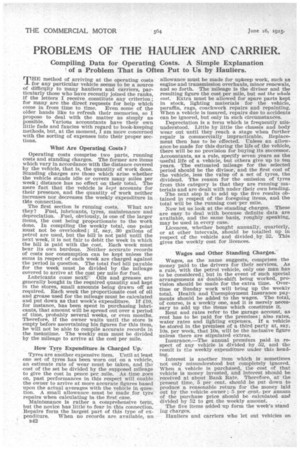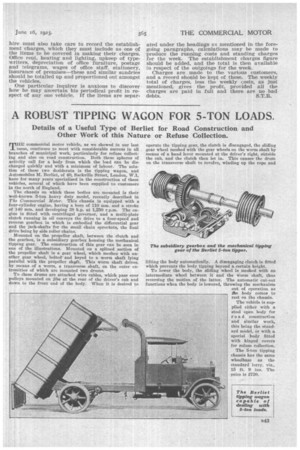PROBLEMS OF THE HAULIER AND CARRIER.
Page 26

Page 27

If you've noticed an error in this article please click here to report it so we can fix it.
Compiling Data for Operating Costs. A Simple Explanation of a Problem That is Often Put to Us by Hauliers.
THE method of arriving at the operating costs for any particular vehicle seems to be a source of difficulty to many hauliers and carriers, particularly those who have recently joined the ranks, if the letters I receive constitute any criterion ; for many are the direct requests for help which come in from time to time. Even some of the older hands like to refresh their memories, so I propose to deal with the matter as simply as possible. Various accountants have their own little fads and fancies with regard to book-keeping methods, but, at the moment, I am more concerned with the sorting of expenses into their proper sections.
What Are Operating Costs ?
Operating costs comprise two parts, running costs and standing charges. The former are items which vary in accordance with the distance covered by the vehicle, that is, the quantity of work done. Standing charges are those which arise whether the vehicle stands idle or covers many miles per week; distance has no effect on their total. The mere fact that the -vehicle is kept accounts for their presence, and the quantity of work neither increases nor decreases the weekly expenditure in tits connection.
The first section is running costs. What are they? Fuel, lubricants, tyres, maintenance and depreciation. Fuel, obviously, is one of the larger items, the cost being proportionate to the work done. In compiling the weekly total, one point must not be overlooked ; if, say, 30 gallons of petrol are used, but the bill is not paid until the next week, it is not fair to debit the week in which the bill is paid with the cost. Each week must bear its own burdens. Neither accurate records of costs nor consumption can he kept unless the sums in respect of each week are charged against the period in question. The total fuel bill payable for the week must be divided by the mileage covered to arrive at the cost per mile for fuel. Lubricants come next. Oils and greases are generally bought in the required quantity and kept in the stores, small amounts being drawn off as required. Each week the proportionate cost of oil and grease used for the mileage must be calculated and put down as that week's expenditure. If £10, for instance, has been spent in purchasing lubricants, that amount will be spread out over a period of time, probably several weeks, or even months. Therefore, if the owner waits until the store is empty before ascertaining his figures for this item, he will not be able to compile accurate records in the meantime. The weekly sum must be divided by the mileage to arrive at the cost per mile.
Ilow Tyre Expenditure is Charged Up.'
Tyres are another expensive item. Until at least one set of tyres has been worn out on a vehicle, an estimate rate of wear must be taken, and the cost of the set be divided by the supposed mileage to give the cost in pence per mile. As time goes on, past performances in this respect will enable the owner to arrive at more accurate figures based upon the actual averages with the vehicle in question. A small allowance must be made for tyre repairs when calculating in the first case.
Maintenance is rather a comprehensive term, but the novice has little to fear in this connection. Repairs form the largest part of this type of expenditure. When no records are available, an B42
allowance must be made for upkeep work, such as engine and transmission overhauls, minor renewals, and so forth. The mileage is the divisor and the resulting figure the cost per mile, but not the whole cost. Extra must be allowed for spare parts kept in stock, lighting materials for the vehicle, paraffin, rags, coachwork repairs and repainting. When a vehicle is insured, repairs due to accidents can be ignored, but only in such circumstances.
Depreciation is a term which is frequently misunderstood. Little by little the chassis and body wear out until they reach a stage when further repair is commercially impracticable. Replacement then has to be effected. Unless an allowance be made for this during the life of the vehicle, there will be no provision for buying its successor. Accountants, as a rule, speeify seven years as the useful life of a vehicle, but others give up to ten years. The estimated mileage for the selected period should be the divisor, and the first cost of the vehicle, less the value of a set of tyres, the dividend. The reason for the omission of tyres from this category is that they are running materials and are dealt with under their own heading. The next step is to add up the five results obtained In respect of the foregoing items, and the total will be the running cost per mile.
Now let us look at the standing charges. These are easy to deal with because definite data are available, and the same basis, roughly speaking, may be used in every case. Licences, whether bought annually, quarterly, or at other intervals, should be totalled up in respect of the vehicle and divided, by 52. This gives the weekly cost for licences.
Wages and Other Standing Charges.
Wages, as the name suggests, comprises the money paid to the drivers for their services. As a rule, with the petrol vehicle, only one man has to be considered; but in the event of such special arrangements as double-shift being worked, provision should be made for the extra time. Overtime or Sunday work will bring up the weekly total. Health and Unemployment Insurance payments should be added to the wages. The total, of course, is a weekly one, and it is merely necessary to add up the items which constitute it. Rent and rates refer to the garage account, as rent has to be paid for the premises ; also rates, water rates and lighting expenses. If a vehicle be stored in the premises of a third party at, say, 10s, per week, that 10s. will be the inclusive figure unless there are stipulated extras.
Insurance.—The annual premium paid in respect of any vehicle is divided by 52, and the result is the weekly expenditure under this heading.
Interest is another item which is sometimes not only misunderstood but completely ignored. When a vehicle is purchased, the cost of that vehicle is money invested, and interest Should be received at about Bank Rate. Therefore, at the present time, 5 per cent. should be put down to produce a reasonable return for the money laid Out by the vehicle owner ; 5 per cent. per annum of the purchase price should be calculated and divided by 52 to get the weekly amount.
The five items added .up form the week's stand ing charges.
Hauliers and carriers who let out vehicles on hire must also take care to record the establishment charges, which they must include as one of the items to be covered in making their charges. Office rent, heating and lighting, upkeep of typewriters, depreciation of office furniture, postage and telegrams, wages of office staff, stationery, insurance of premises—these and similar sundries should be totalled up and proportioned out amongst the vehicles.
One particular inquirer is anxious to discover how he may ascertain his periodical profit in respect of any one vehicle. If the items are separ ated under the headings ai mentioned in the foregoing paragraphs, calculations may be made to produce the running costs and standing charges for the week. The establishment charges figure should be added, and the total is then available in respect of the outgoings for the week. Charges are made to the various customers, and a record should be kept of these. The weekly total of charges, less the weekly costs, as just mentioned, gives the profit, provided all the charges are paid in full and there are no bad debts. S.T.R.






























